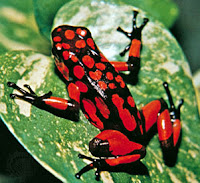 Poison dart frog (also dart-poison frog, poison frog or formerly poison arrow frog) is the common name of a group of frogs in the family Dendrobatidae which are native to Central and South America. These species are diurnal and often have brightly-colored bodies. Although all wild dendrobatids are at least somewhat toxic, levels of toxicity vary considerably from one species to the next and from one population to another. Many species are critically endangered.
Poison dart frog (also dart-poison frog, poison frog or formerly poison arrow frog) is the common name of a group of frogs in the family Dendrobatidae which are native to Central and South America. These species are diurnal and often have brightly-colored bodies. Although all wild dendrobatids are at least somewhat toxic, levels of toxicity vary considerably from one species to the next and from one population to another. Many species are critically endangered.
 Characteristics
Characteristics
Most species of poison dart frogs are small, sometimes less than 1.5 centimeters (0.59 in) in adult length, although a few grow up to 6 centimeters (2.4 in) in length. They weigh about 2 grams, depending on the size of the frog. Most poison dart frogs are brightly colored, displaying aposematic patterns to warn potential predators. Their bright coloration is associated with their toxicity and levels of alkaloids. Frogs like the ones of Dendrobates species have high levels of alkaloids, whereas the Colostethus species are cryptically colored and are nontoxic
Poison dart frogs are an example of an aposematic organism. Their bright coloration advertises unpalatability to potential predators. Aposematism is currently thought to have originated at least four times within the poison dart family according to phylogenetic trees, and dendrobatid frogs have since undergone dramatic divergences- both interspecific and intraspecific- in their aposematic coloration. This is surprising given the frequency-dependent nature of this type of defense mechanism.
Adult frogs lay their eggs in moist places, including on leaves, in plants, among exposed roots, and elsewhere. The poison dart frog is an amphibian. Once the eggs hatch, the adult piggybacks the tadpoles, one at a time, to suitable water, either a pool, or the water gathered in the throat of bromeliads or other plants. The tadpoles remain there until they metamorphose, fed by unfertilized eggs laid at regular intervals by the mother.
Ecosystem
Poison dart frogs are endemic to humid, tropical environments of Central and Latin America (South America). These frogs are generally found in tropical rain forests, including in Bolivia, Costa Rica, Brazil, Colombia, Ecuador, Venezuela, Suriname, French Guiana, Peru, Panama, Guyana, Nicaragua, and Hawaii (introduced).
Natural habitats include subtropical or tropical, moist, lowland forests, subtropical or tropical high-altitude shrubland, subtropical or tropical, moist, mountains and rivers, freshwater marshes, intermittent freshwater marshes, lakes and swamps. Other species can be found in seasonally wet or flooded lowland grassland, arable land, pastureland, rural gardens, plantations, moist savanna and heavily degraded former forest. Premontane forests and rocky areas have also been known to hold frogs. Dendrobatids tend to live on or close to the ground, but also in trees as much as 10 meters (33 ft) from the ground.
Color Morphs
Some poison dart frogs species include a number of nonspecific color morphs that emerged as recently as 6,000 years ago. Therefore, species such as Dendrobates tinctorius, Oophaga pumilio, and O. granulifera can include color pattern morphs that can be interbred (colors are under polygenic control, while the actual patterns are probably controlled by a single locus). Differing coloration has historically misidentified single species as separate, and there is still controversy among taxonomists over classification.
Toxicity
Many poison dart frogs secrete lipophilic alkaloid toxins through their skin. Alkaloids in the skin glands of poison frogs serve as a chemical defense against predation, and they are therefore able to be active alongside potential predators during the day. About 28 structural classes of alkaloids are known in poison frogs. The most toxic of poison dart frog species is Phyllobates terribilis. It is argued that dart frogs do not synthesize their poisons, but sequester the chemicals from arthropod prey items, such as ants, centipedes and mites - the diet-toxicity hypothesis. Because of this, captive-bred animals do not possess significant levels of toxins as they are reared on diets that do not contain the alkaloids sequestered by wild populations. Nonetheless, the captive-bred frogs retain the ability to accumulate alkaloids when they are once again provided an alkaloid containing diet. Despite the toxins used by some poison dart frogs, some predators have developed the ability to withstand them. One is the snake called Leimadophis epinephelus which has developed immunity to the poison.
Medicine
Chemicals extracted from the skin of Epipedobates tricolor may be shown to have medicinal value. Scientists use this poison to make a pain killer. One such chemical is a painkiller 200 times as potent as morphine, called epibatidine, that has unfortunately demonstrated unacceptable gastrointestinal side effects in humans. Secretions from dendrobatids are also showing promise as muscle relaxants, heart stimulants and appetite suppressants. The most poisonous of these frogs, the golden poison frog (Phyllobates terribilis), has enough toxin on average to kill ten to 20 men or about ten thousand mice. Most other dendrobatids, while colorful and toxic enough to discourage predation, pose far less risk to humans or other large animals.




















No comments:
Post a Comment